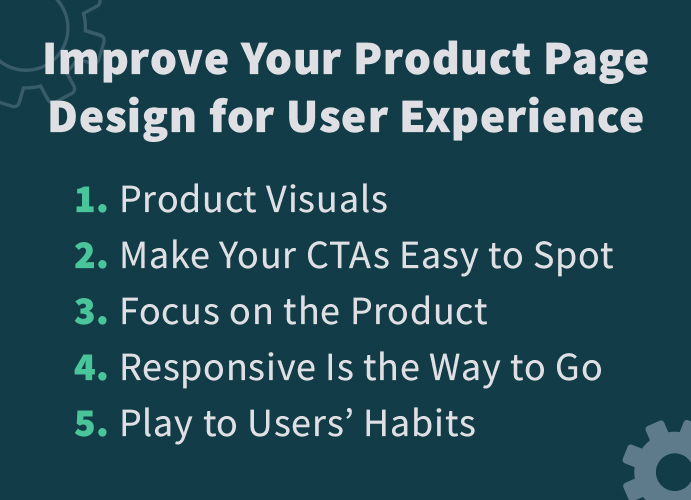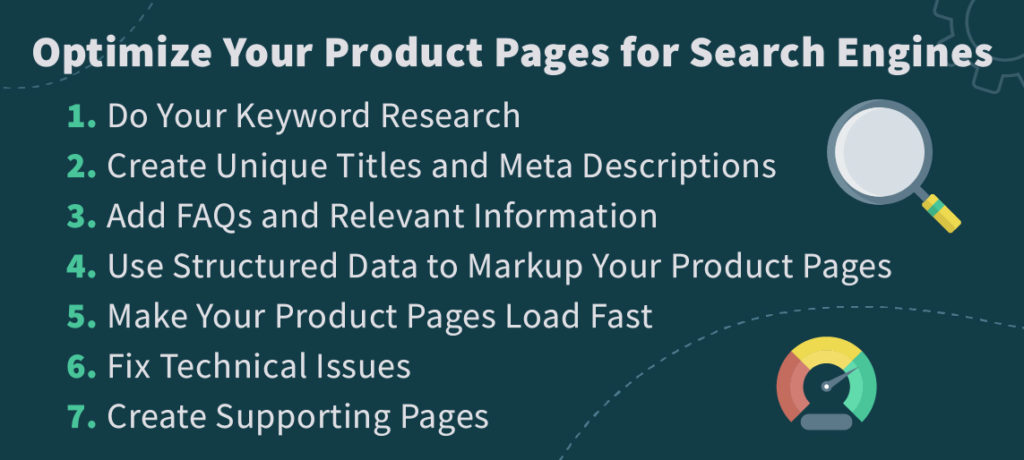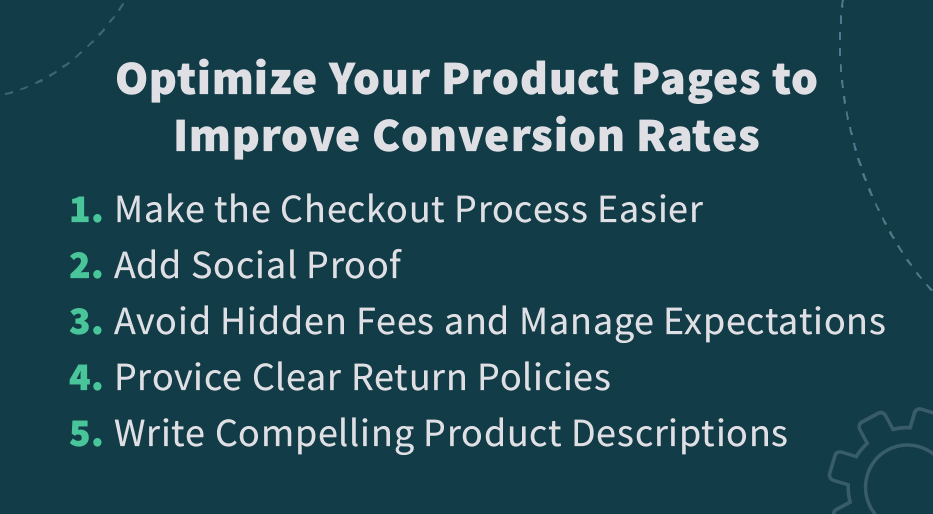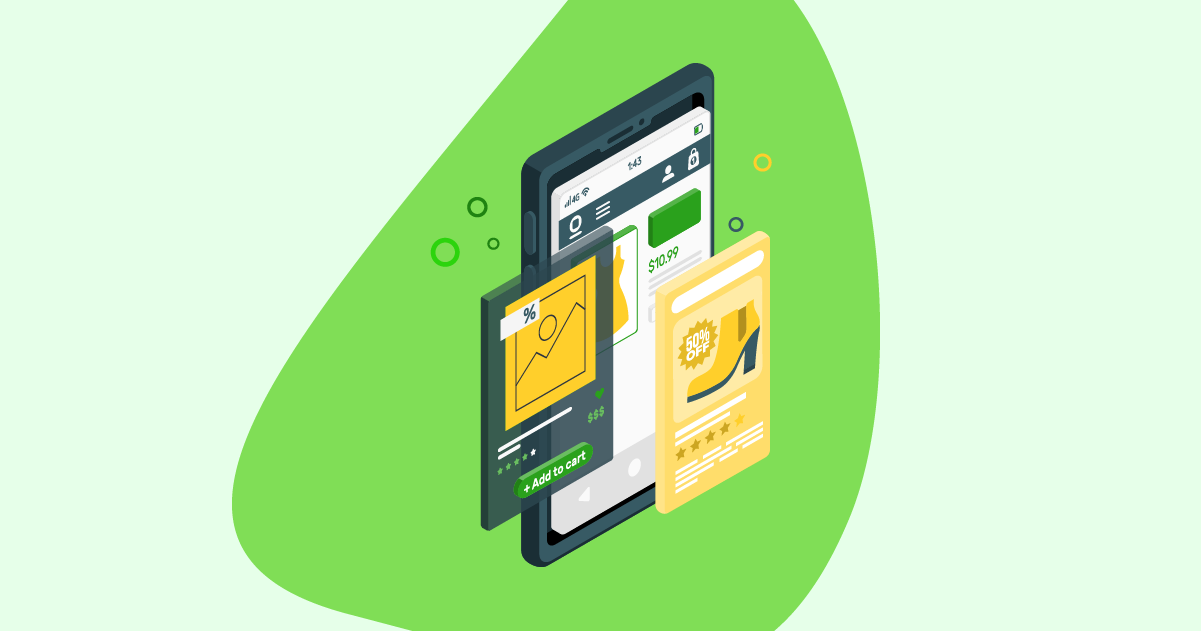Product pages are to websites what sales professionals are to a store. These pages are meant to showcase your products and their variations, provide a great experience, and close sales.
With that in mind, optimizing your product pages for both discoverability (SEO) and conversions (CRO) is a fundamental task for any eCommerce site that’s looking to increase its revenue. So, what are optimized product pages?
In this article, we’ll be discussing different optimization considerations you’ll need to keep in mind while working on your product pages. These best practices can be implemented during the planning phase or for existing product pages, so no matter which stage your business is in, you’ll find something useful and practical.
Although we’re inclined to talk about SEO first – after all, that’s a big part of what we do at Prerender -, let’s start with one of the essential optimizations for product pages: user experience.

Improve Your Product Page Design for User Experience (UX)
Many elements influence the experience of the user. However, the design of your product page will dictate the first impression and “feel” of the page.
After all, eCommerce is very dependent on its visual presentations. Because consumers can’t walk through your store’s door to touch, feel and interact with your products, you’ll need to use another channel to help them make a purchasing decision.
When it comes to design product pages, it all comes down to how you plan and display every element. Of course, all product pages are different, but there are a few typical elements all of them should have.
Here’s a product page elements checklist from Tubik Studios:
- name/title of the item
- photo
- price
- item availability
- add to cart/add to bag/add to basket/buy button
- add to favorites/save to wishlist button
- description
- social proof: rating, reviews, the number of previous buyers, the number of people looking at the item now, etc.
- choice of color
- choice of model
- selection of the number of items to buy
- size guide or calculator (for clothes and footwear)
- extended details (materials, technical specifications, dimensions, weight, special features, etc.)
You don’t need to add all these elements if they don’t fit your customers’ needs, but these are the elements we will use to create our product page more often than not.
Why does it matter? Because this gives us a framework for the rest of our work, as we’ll be using each of these elements when crafting our layout, writing the copy, and optimizing for SEO.
1. Images & Product Visuals
A key element of your product pages is how you display your products. The visuals you use inside your page need to communicate to the customer what the product, and its variations, looks like, how it feels to use it, and the style.
These visuals don’t need to be just a photo. It can be videos, animations, 360-degree views, or even AR presentations.
Master Dynamics uses a big and stunning image for their hero sections. In the case of the MW65 headphones, the image showcases the beautiful design and its high-quality, durable materials.
But in the following section, they allow users to switch between colors and different product angles.
Because these are headphones – and most humans already know how they work – Master Dynamics focuses on showing the style of the product, uses big letters for their titles, and keeps navigation quite simple.
These are a few best practices to follow:
- All visuals must be high-quality. Avoid pixelated photos or poorly directed videos. The visuals will heavily impact your customers’ decisions, so you want them to have the best impression possible.
- Keep function in mind. For shorts and t-shirts, use photos from different angles and use models to help customers visualize themselves using your clothes. However, for more complex products like electronics, having a video demonstrating how to use the product itself is a better choice.
- Optimize your assets for the web. Remember that customers will have to download all the assets on your page, so if your image and video files are too large, it will negatively impact the overall user experience.
- Make them stand out. Original ideas increase customer engagement, which causes them to stay on the site longer. Add your style and brand to your product visualizations.
2. Make Your CTAs Easy to Spot
A call to action (CTA) is a directive that tells users the best next step in their journey. For most product pages, it will be the buy or add to cart button.
When designing your CTAs, make sure to:
- Only add one CTA per page or section.
- Make it as easy as possible to see by using contrast, different fonts, etc.
- Write an easy-to-follow directive, asking for users to do only one thing at a time.
Poo-Pourri uses mostly white backgrounds, so they use a blue background for their CTAs. After seeing the image, users’ eyes will quickly focus on the ‘ADD TO CART’ button, shortening the time it takes to orient themselves upon arriving on the page.
3. Focus on the product
We might be tempted to add as much information, images, interactions, and elements as we can to persuade visitors to convert. However, it will often just distract users from what really matters: your product.
Everything on the page should make your product stand out and serve as a way to convey the benefits and feel of it.
Try to delete anything that doesn’t support this goal directly and let your product do the talking. This also means keeping an eye on the hierarchy of the elements. Product images and titles should be easy to spot, helping users scan the page quickly.
You can follow the inverted pyramid approach. Although this approach was developed for writing, your layout should follow the same principles.
Everything that the user needs to know must be given top priority and displayed at the top of the page, while things that are good to know or see should follow.
4. Responsive Is the Way to Go
Optimizing your website for mobile devices isn’t a choice anymore. For both users and search engines, an excellent mobile experience is a must.
You’ll want to make your page behavior and structure consistent across all devices, without forgetting that your design needs to adapt to smaller screens and weaker internet connections correctly.
A great way to keep a consistent design on mobile is to use a grid approach. Making every element fit in a grid means that each element can be stacked on top of the other without losing the essence of your layout.
5. Play to Users’ Habits
Although we all want to innovate, there are some conventions we have to respect. Websites are not meant to be just pure artistic expression. They have a clear function and goal to achieve, and the first step to accomplishing that is ease of use.
For example, most users would feel frustrated or disoriented if we change what is commonly used to indicate a search field: the magnifying glass icon.
These commonly-accepted conventions are important for us when designing our product pages because users recognize these symbols. Thus, they make our product pages easier to navigate.

Optimize Your Product Pages for Search Engines
Now that our product pages are well designed with the user at the center, it is time to get some eyes on them.
There’s no point in having the most appealing store if no one comes through the door. That’s where search engine optimization (SEO) comes in.
“Google processes over 3.5 billion searches per day” and “46 percent of product searches begin on Google”, according to Oberlo. By the numbers alone, you can understand the impact having a presence in Google search results can have on your business.
The goal of search engines is to show the best result possible to their users. That’s why user experience is so important.
Let’s explore the most important elements you’ll need to optimize to start ranking your product pages:
1. Do Your Keyword Research
Keyword research is something many developers and business owners overlook when creating pages, but it’s the foundation for any SEO effort.
Unlike blog posts and other informational pages, product pages have a clear conversion goal. They are meant to sell a product, not just to inform about them.
With that in mind, here are a few tips to follow:
Look for Keywords with Transactional Intent
In that sense, when conducting keyword research for product pages, the angle must be to find queries with a clear buying or transactional intent.
Without getting into the nitty-gritty of search intent, users researching with transactional intent are people ready to buy, for the most part.
For example, people looking for “how to clean my floor” are most likely looking for a step-by-step guide (information intent), but those searching for “wax for wooden floors” are exploring product options (transactional intent).
Use Existing Ad Data
If you have a Google Ads campaign, look for keywords with decent search volume and a high click-through rate (CTR). These are probably some of the best targets for your SEO efforts.
A high CTR means there’s purchasing motivation associated with the term, so ranking for these keywords will likely bring traffic, which can lead to an increase in sales.
Remember that Relevance is Key
Don’t base keyword decisions on search volume alone. Use keywords that make sense for your products.
Remember that search engines want to show the best result possible, and if your product doesn’t match the intent behind the query, no amount of time and money will make them rank.
Always ask yourself: is my product the best result for this particular term?
2. Create Unique Titles and Meta Descriptions
As you may have figured out, product pages don’t have that much content on them, at least not as much as informational pages do, so every bit of text matters.
Titles and meta descriptions are the first touchpoint for both search engines and consumers. When crawling your pages, bots (Google, Bing, etc.) will use the title and meta description to determine what the page is about.
Additionally, this is the text that search engines will display on the results page, so think of it as a billboard for your store.
When crafting your title remember to:
- Add the name and model of the product
- Add your brand
- Add your keyword
- Keep it under 60 characters
Meta descriptions have a little bit more leeway:
- Include your primary keyword or a related keyword in the text
- Start with a hook to make the reader interested
- Keep it under 160 characters
- Showcase a unique feature or benefit of your product
Note: If you need help writing your meta description, the team at CanIRank pulled together ten ways to write killer meta descriptions. Check it out!
3. Add FAQs and Relevant Information
Frequently Asked Questions are a great way to add more value to your product pages. These can help with conversion by addressing buyers’ doubts and can help with SEO by adding more signals to search engines.
For example, with chemical products like creams, people may have health concerns that they might be searching online. You can add an FAQ to answer these questions to ease their minds and increase their chances of ranking for related queries.
4. Use Structured Data to Markup Your Product Pages
Structured data, also known as schema markup, is a standardized format of code that communicates to search engines additional information about the content on a page in a language bots can understand.
This allows you to give more context to Google and help it better understand your page, making it easier to index.
While schema doesn’t impact rankings directly, Product and Review schema are useful for products and can result in rich snippets showing in SERPS.
Review schema turns into review stars, and product schema can lead to prices, stock, and other important information showing in search results.
While FAQPages schema will display the FAQ itself in the search results.
Result from Zogics antibacterial wipes with rich results
As you can imagine, rich results make your link stand out from the rest of the results. Attracting more clicks will translate to more chances to close a sale.
Note: Here’s a complete guide on using structured data for SEO with code examples ready for implementation.
5. Make Your Product Pages Load Fast
Slow loading speed is one of the key factors that leads to high bounce rates and poor user experience. No customer wants to wait around until your product page is ready.
In most cases, people will leave as soon as they are greeted by a blank page.
To increase page speed, there are a few quick tasks you can implement:
- Compress your photos and images using TinyGPG. Images are the largest files on your page, so make sure that they are appropriately compressed to make them load faster.
- Rize your visual assets to what’s actually displayed. In other words, don’t use a 4000 x 4000 image when the largest screen only loads 1280 x 720.
- Reduce JavaScript execution time. Until necessary JavaScript files are loaded, browsers will delay the execution of HTML and CSS files, which is where the content is, making your website slower for the user. A good practice is to defer JavaScript loading, letting priority files load first.
Prerender’s CTO, Zoltan Bettenbuk, wrote a detailed and practical guide on page speed optimization worth checking.
However, in May 2020 Google announced the core web vitals update. These new ranking factors are meant to measure user experience in a more rigorous manner by analyzing:
- Largest Contentful Paint (LCP): the time it takes for the largest element on the page to load.
- First Input Delay (FID): the time it takes for the page to become interactive.
- Cumulative Layout Shift (CLS): when the page’s layout moves as it loads.
Core web vitals are an integral part of page speed optimization. Google provides a score for each factor, and your page needs to pass each one to benefit from the boost in ranking.
We won’t expand too much on this in this article, but you can check our how-to pass core web vitals guide for more in-depth and practical tips. Each tip is easy to follow and will have a clear impact on your metrics.
That said, a few of the optimizations previously mentioned will help you fix a few core web vitals problems, so make sure to implement those first.
6. Fix Technical Issues
Technical issues can prevent search engines from crawling your pages or block them from accessing the content altogether.
To identify technical problems, you’ll need to run a technical site audit. For this, you can use tools like Screaming Frog, Ahrefs, Moz, and PageSpeed Insights. These tools will crawl your site and report any problems they detect.
Use our complete technical SEO site audit checklist to discover all the issues that could be holding your site back. Once the issues are identified, you can create a strategy to solve them.
In our experience, these are the most common technical issues product pages face:
- Content locked behind JavaScript. Search engines can’t interact with your page, so they are unable to access any content that requires a user to trigger an event. A common occurrence is adding links inside a click event instead of using an href attribute inside an <a> tag. Here are more examples of common javascript issues and how to solve them.
- Duplicate and thin content. Again, not all product pages will have a lot of text, so they might be seen as thin content. Another common problem is similar products getting flagged as duplicates. Some ways to solve this are adding FAQs, benefits, and reviews to the page to add more content and combining products where it makes sense, like color or size variations that could be one listing with option selectors.
- Auto-Generated URLs. Every URL should be unique, readable, and clear. Avoid symbols, numbers, unless they’re relevant to the model, and gibberish. Also, don’t change them too often, if at all.
- Out of stock product pages appearing as 404 pages. Unless the product won’t come back, avoid redirecting out-of-stock items to 404 error pages. This will make them drop from their rankings, and getting them back will be extremely difficult.
- Crawling issues. This is especially common for huge eCommerce websites with hundreds of URLs. If you find that Google isn’t crawling your site correctly or is leaving a lot of pages out, follow our guide on crawl budget optimization for SEO.
7. Create Supporting Pages
Supporting pages are mostly informational or resource pages that help your most important pillar or product pages rank higher by sending relevant traffic.
Let’s take Turmerry as an example. Turmerry is an eCommerce store focused on selling bed sheets, mattresses, and more home items.
As part of their SEO strategy, they build articles like “how often should you wash and clean your sheets?” to attract relevant traffic to their site. In this case, the relevant traffic includes people interested in sheets.
Also, it is easier to build backlinks to informational pages than it is for product pages. After all, why would anyone link to a product page?
However, by building links to these supporting pages, you can point internal links to your product pages to pass some of the authority.

Optimize Your Product Page to Improve Conversion Rates
Design? Check! Discoverability, aka, SEO? Check! It’s time to add the cherry on top: conversion rate optimization (CRO).
Although we’re leaving CRO for last, it doesn’t mean there’s a rigid hierarchy between these three pillars. You might have noticed that design, SEO, and CRO work together.
A lot of SEO and design optimizations will help your pages convert better because you are showing the right content to the right audience.
We won’t mention FAQs again, not because they are not helpful for conversions but because we already covered them as part of the SEO optimization process.
With that said, here are six strategies you can use to create a high-converting product page:
1. Make the Checkout Process Easier
A lot of customers will bounce immediately from a long, complex checkout page. If they don’t feel comfortable during this experience, they won’t complete their purchase.
To simplify the process, make sure to:
- Eliminate any external links from your checkout pages
- Keep the process to one or two pages
- Let your customers buy without creating an account
- Provide several payment options
A nice touch is displaying the product on every checkout page to keep it in the customer’s mind.
2. Add Social Proof
People want to make sure they are making the right choice. Placing customers’ feedback and reviews (especially if they can write it directly on the site) will help you build trust with new customers.
3. Avoid Hidden Fees and Manage Expectations
Always be transparent with your pricing. Nothing scares customers faster than getting to the checkout page thinking they will pay $11 and then realizing it’s actually $30 after taxes and shipping.
Shipment fees and taxes should be discussed on the product page to provide all the information the customer needs to make a decision. It has the additional benefit of filtering visitors that are not ready to buy. If they already know the exact amount they will pay, it should increase your success rate.
4. Provide Clear Return Policies
Unlike buying in person, people can’t really touch and feel your products. That means they need to trust your business enough to purchase from you.
A clear return policy will take a lot of stress out of the customer’s mind because they know that they can still get their money back if anything happens to their product.
Return policies don’t need to be a creative masterpiece, but they must be clear and concise. Here’s a guide on how to write effective return policies you can use to write yours.
5. Write Compelling Product Descriptions
Your product description is the product’s pitch. Its goal is to tell the customer what the product is, what makes it unique, and compel them to buy.
Shopify provides a simple framework for writing product descriptions:
- What problems does your product solve?
- What do customers gain from your product?
- What makes it better than the competition?
Product descriptions should be both creative and persuasive, as well as being optimized with your target keyword in mind.
Coming back to the inverted pyramid, your product description should have all the information the customer must know without any fluff.
Wrapping Up
Alright, you made it! Thanks so much for sharing this journey with us. We hope you enjoyed this article and learned a few tricks to try out. Now it’s time to put all your new knowledge into practice.
If you don’t know where to start, we recommend running a complete technical audit to find quick wins and critical issues to tackle. It will also guide you towards what tasks need to be prioritized and which need to be delegated to developers and designers.Send us all your questions on our Twitter. We’ll be happy to help!



